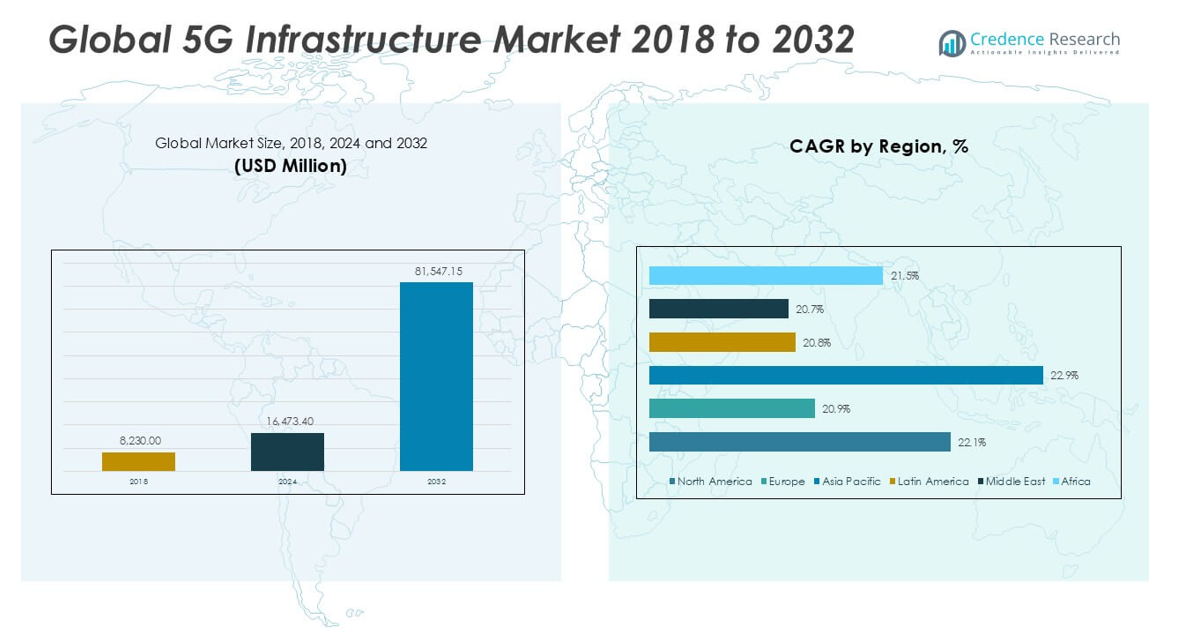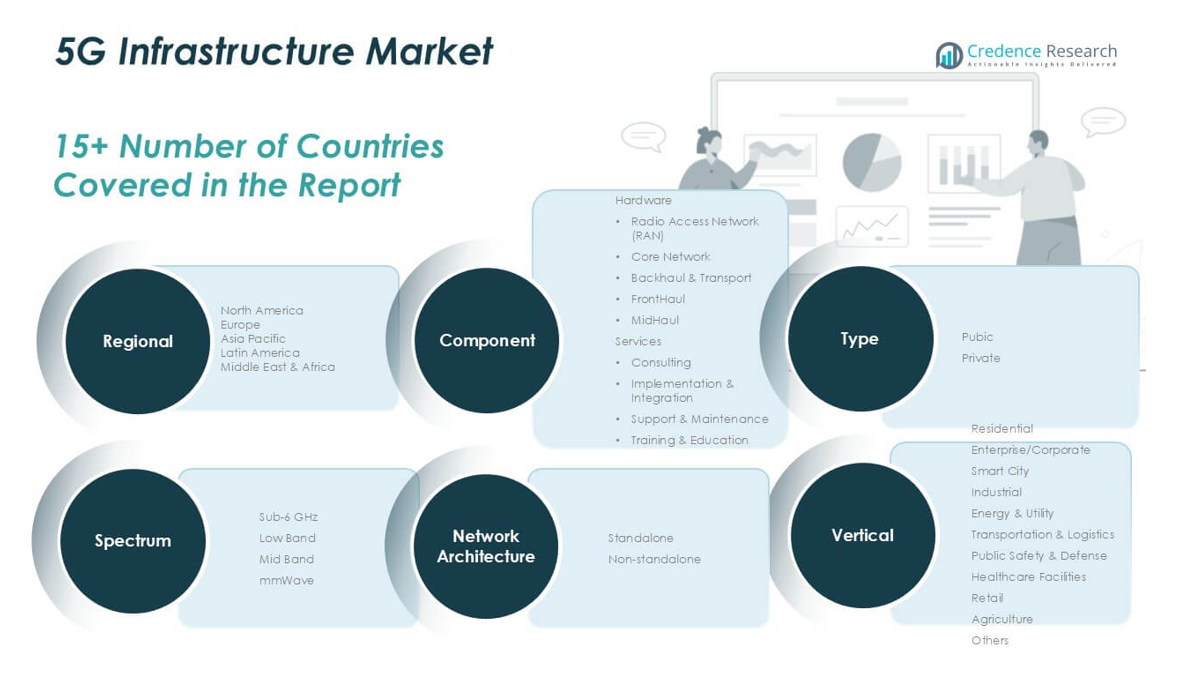CHAPTER NO. 1 : GENESIS OF THE MARKET
1.1 Market Prelude – Introduction & Scope
1.2 The Big Picture – Objectives & Vision
1.3 Strategic Edge – Unique Value Proposition
1.4 Stakeholder Compass – Key Beneficiaries
CHAPTER NO. 2 : EXECUTIVE LENS
2.1 Pulse of the Industry – Market Snapshot
2.2 Growth Arc – Revenue Projections (USD Million)
2.3. Premium Insights – Based on Primary Interviews
CHAPTER NO. 3 : 5G INFRASTRUCTURE MARKET FORCES & INDUSTRY PULSE
3.1 Foundations of Change – Market Overview
3.2 Catalysts of Expansion – Key Market Drivers
3.2.1 Momentum Boosters – Growth Triggers
3.2.2 Innovation Fuel – Disruptive Technologies
3.3 Headwinds & Crosswinds – Market Restraints
3.3.1 Regulatory Tides – Compliance Challenges
3.3.2 Economic Frictions – Inflationary Pressures
3.4 Untapped Horizons – Growth Potential & Opportunities
3.5 Strategic Navigation – Industry Frameworks
3.5.1 Market Equilibrium – Porter’s Five Forces
3.5.2 Ecosystem Dynamics – Value Chain Analysis
3.5.3 Macro Forces – PESTEL Breakdown
3.6 Price Trend Analysis
3.6.1 Regional Price Trend
3.6.2 Price Trend by product
CHAPTER NO. 4 : KEY INVESTMENT EPICENTER
4.1 Regional Goldmines – High-Growth Geographies
4.2 Product Frontiers – Lucrative Product Categories
4.3 Type Sweet Spots – Emerging Demand Segments
CHAPTER NO. 5: REVENUE TRAJECTORY & WEALTH MAPPING
5.1 Momentum Metrics – Forecast & Growth Curves
5.2 Regional Revenue Footprint – Market Share Insights
5.3 Segmental Wealth Flow – Component & Type Revenue
CHAPTER NO. 6 : TRADE & COMMERCE ANALYSIS
6.1.Import Analysis by Region
6.1.1. Global 5G Infrastructure Market Import Revenue By Region
6.2.Export Analysis by Region
6.2.1. Global 5G Infrastructure Market Export Revenue By Region
CHAPTER NO. 7 : COMPETITION ANALYSIS
7.1.Company Market Share Analysis
7.1.1. Global 5G Infrastructure Market: Company Market Share
7.2. Global 5G Infrastructure Market Company Revenue Market Share
7.3.Strategic Developments
7.3.1.Acquisitions & Mergers
7.3.2. New Product Launch
7.3.3. Regional Expansion
7.4. Competitive Dashboard
7.5. Company Assessment Metrics, 2024
CHAPTER NO. 8 : 5G INFRASTRUCTURE MARKET – BY COMPONENT SEGMENT ANALYSIS
8.1.5G Infrastructure Market Overview by Component Segment
8.1.1. 5G Infrastructure Market Revenue Share By Component
8.2. Hardware
8.2.1 Radio Access Network (RAN)
8.2.2 Core Network
8.2.3 Backhaul & Transport
8.2.4 FrontHaul
8.2.5 MidHaul
8.3.Services
8.3.1 Consulting
8.3.2 Implementation & Integration
8.3.3 Support & Maintenance
8.3.4 Training & Education
CHAPTER NO. 9 : 5G INFRASTRUCTURE MARKET – BY TYPE SEGMENT ANALYSI
9.1.5G Infrastructure Market Overview by Type Segment
9.1.1. 5G Infrastructure Market Revenue Share By Type
9.2. Public
9.3.Private
CHAPTER NO. 10 : 5G INFRASTRUCTURE MARKET – BY SPECTRUM SEGMENT ANALYSIS
10.1.5G Infrastructure Market Overview by Spectrum Segment
10.1.1. 5G Infrastructure Market Revenue Share By Spectrum
10.2.Sub-6 GHz
10.3. Low Band
10.4. Mid Band
10.5. mmWave
CHAPTER NO. 11 : 5G INFRASTRUCTURE MARKET – BY NETWORK ARCHITECTURE SEGMENT ANALYSIS
11.1.5G Infrastructure Market Overview by Network Architecture Segment
11.1.1. 5G Infrastructure Market Revenue Share By Network Architecture
11.2. Standalone
11.3.Non-standalone
CHAPTER NO. 12 : 5G INFRASTRUCTURE MARKET – BY VERTICAL SEGMENT ANALYSIS
12.1.5G Infrastructure Market Overview by Vertical Segment
12.1.1. 5G Infrastructure Market Revenue Share By Vertical
12.2.Residential
12.3. Enterprise/Corporate
12.4. Smart City
12.5. Industrial
12.6. Energy & Utility
12.7. Transportation & Logistics
12.8. Public Safety & Defense
12.9. Healthcare Facilities
12.10. Retail
12.11 Agriculture
12.12 Others
CHAPTER NO. 13 :5G INFRASTRUCTURE MARKET – REGIONAL ANALYSIS
13.1.5G Infrastructure Market Overview by Region Segment
13.1.1. Global 5G Infrastructure Market Revenue Share By Region
13.1.2.Regions
13.1.3.Global 5G Infrastructure Market Revenue By Region
13.1.4.Component
13.1.5.Global 5G Infrastructure Market Revenue By Component
13.1.6.Type
13.1.7. Global 5G Infrastructure Market Revenue By Type
13.1.8.Spectrum
13.1.9. Global 5G Infrastructure Market Revenue By Spectrum
13.1.10. Network Architecture
13.1.12. Global 5G Infrastructure Market Revenue By Network Architecture
13.1.13. Vertical
13.1.14. Global 5G Infrastructure Market Revenue By Vertical
CHAPTER NO. 14 : NORTH AMERICA 5G INFRASTRUCTURE MARKET – COUNTRY ANALYSIS
14.1.North America 5G Infrastructure Market Overview by Country Segment
14.1.1.North America 5G Infrastructure Market Revenue Share By Region
14.2.North America
14.2.1.North America 5G Infrastructure Market Revenue By Country
14.2.2.Component
14.2.3.North America 5G Infrastructure Market Revenue By Component
14.2.4.Type
14.2.5.North America 5G Infrastructure Market Revenue By Type
14.2.6.Spectrum
14.2.7.North America 5G Infrastructure Market Revenue By Spectrum
14.2.8.Network Architecture
14.2.9.North America 5G Infrastructure Market Revenue By Network Architecture
14.2.10.Vertical
14.2.11.North America 5G Infrastructure Market Revenue By Vertical
14.3.U.S.
14.4.Canada
14.5.Mexico
CHAPTER NO. 15 : EUROPE 5G INFRASTRUCTURE MARKET – COUNTRY ANALYSIS
15.1. Europe 5G Infrastructure Market Overview by Country Segment
15.1.1. Europe 5G Infrastructure Market Revenue Share By Region
15.2.Europe
15.2.1.Europe 5G Infrastructure Market Revenue By Country
15.2.2.Component
15.2.3.Europe 5G Infrastructure Market Revenue By Component
15.2.4.Type
15.2.5. Europe 5G Infrastructure Market Revenue By Type
15.2.6.Spectrum
15.2.7. Europe 5G Infrastructure Market Revenue By Spectrum
15.2.8.Network Architecture
15.2.9. Europe 5G Infrastructure Market Revenue By Network Architecture
15.2.10.Vertical
15.2.11. Europe 5G Infrastructure Market Revenue By Vertical
15.3.UK
15.4.France
15.5.Germany
15.6.Italy
15.7.Spain
15.8.Russia
15.9. Rest of Europe
CHAPTER NO. 16 : ASIA PACIFIC 5G INFRASTRUCTURE MARKET – COUNTRY ANALYSIS
16.1.Asia Pacific 5G Infrastructure Market Overview by Country Segment
16.1.1.Asia Pacific 5G Infrastructure Market Revenue Share By Region
16.2.Asia Pacific
16.2.1. Asia Pacific 5G Infrastructure Market Revenue By Country
16.2.2.Component
16.2.3.Asia Pacific 5G Infrastructure Market Revenue By Component
16.2.4.Type
16.2.5.Asia Pacific 5G Infrastructure Market Revenue By Type
16.2.6.Spectrum
16.2.7.Asia Pacific 5G Infrastructure Market Revenue By Spectrum
16.2.8.Network Architecture
16.2.9.Asia Pacific 5G Infrastructure Market Revenue By Network Architecture
16.2.10.Vertical
16.2.11.Asia Pacific 5G Infrastructure Market Revenue By Vertical
16.3.China
16.4.Japan
16.5.South Korea
16.6.India
16.7.Australia
16.8.Southeast Asia
16.9. Rest of Asia Pacific
CHAPTER NO. 17 : LATIN AMERICA 5G INFRASTRUCTURE MARKET – COUNTRY ANALYSIS
17.1.Latin America 5G Infrastructure Market Overview by Country Segment
17.1.1.Latin America 5G Infrastructure Market Revenue Share By Region
17.2. Latin America
17.2.1. Latin America 5G Infrastructure Market Revenue By Country
17.2.2.Component
17.2.3. Latin America 5G Infrastructure Market Revenue By Component
17.2.4.Type
17.2.5.Latin America 5G Infrastructure Market Revenue By Type
17.2.6.Spectrum
17.2.7.Latin America 5G Infrastructure Market Revenue By Spectrum
17.2.8.Network Architecture
17.2.9.Latin America 5G Infrastructure Market Revenue By Network Architecture
17.2.10.Vertical
17.2.11.Latin America 5G Infrastructure Market Revenue By Vertical
17.3.Brazil
17.4.Argentina
17.5.Rest of Latin America
CHAPTER NO. 18 : MIDDLE EAST 5G INFRASTRUCTURE MARKET – COUNTRY ANALYSIS
18.1.Middle East 5G Infrastructure Market Overview by Country Segment
18.1.1.Middle East 5G Infrastructure Market Revenue Share By Region
18.2.Middle East
18.2.1. Middle East 5G Infrastructure Market Revenue By Country
18.2.2.Component
18.2.3.Middle East 5G Infrastructure Market Revenue By Component
18.2.4.Type
18.2.5.Middle East 5G Infrastructure Market Revenue By Type
18.2.6. Spectrum
18.2.7.Middle East 5G Infrastructure Market Revenue By Spectrum
18.2.8. Network Architecture
18.2.9.Middle East 5G Infrastructure Market Revenue By Network Architecture
18.2.10. Vertical
18.2.11.Middle East 5G Infrastructure Market Revenue By Vertical
18.3.GCC Countries
18.4. Israel
18.5. Turkey
18.6.Rest of Middle East
CHAPTER NO. 19 : AFRICA 5G INFRASTRUCTURE MARKET – COUNTRY ANALYSIS
19.1. Africa 5G Infrastructure Market Overview by Country Segment
19.1.1.Africa 5G Infrastructure Market Revenue Share By Region
19.2. Africa
19.2.1.Africa 5G Infrastructure Market Revenue By Country
19.2.2.Component
19.2.3.Africa 5G Infrastructure Market Revenue By Component
19.2.4.Type
19.2.5. Africa 5G Infrastructure Market Revenue By Type
19.2.6.Spectrum
19.2.7. Africa 5G Infrastructure Market Revenue By Spectrum
19.2.8.Network Architecture
19.2.9. Africa 5G Infrastructure Market Revenue By Network Architecture
19.2.10.Vertical
19.2.11. Africa 5G Infrastructure Market Revenue By Vertical
19.3. South Africa
19.4.Egypt
19.5.Rest of Africa
CHAPTER NO. 20 : COMPANY PROFILES
20.1. Huawei Technologies Co., Ltd.
20.1.1.Company Overview
20.1.2.Product Portfolio
20.1.3.Financial Overview
20.1.4.Recent Developments
20.1.5.Growth Strategy
20.1.6.SWOT Analysis
20.2. Samsung Electronics Co., Ltd.
20.3. Nokia Corporation
20.4. Telefonaktiebolaget LM Ericsson
20.5. ZTE Corporation
20.6. NEC Corporation
20.7. Cisco Systems, Inc.
20.8. Fujitsu Limited
20.9. Comba Telecom Systems Holdings Ltd.
20.10. Airspan Networks
20.11. Mavenir
20.12. Parallel Wireless
20.13. Ceragon
20.14. Aviat Networks, In









